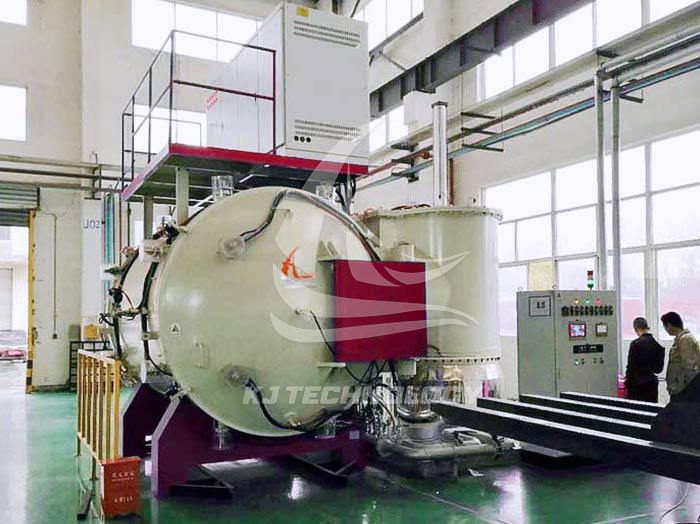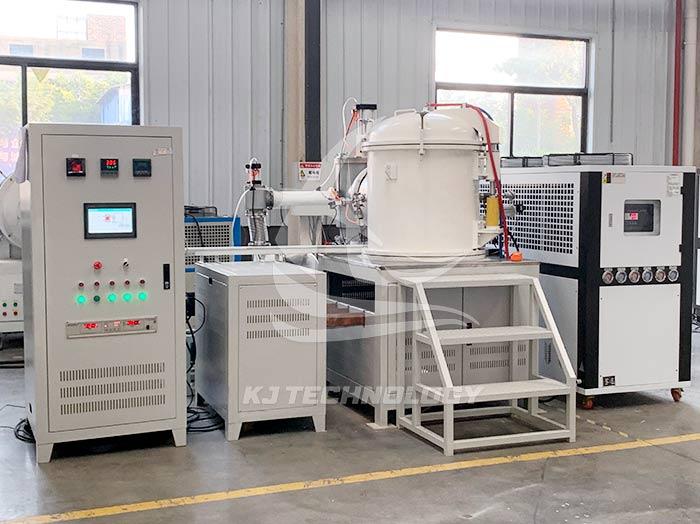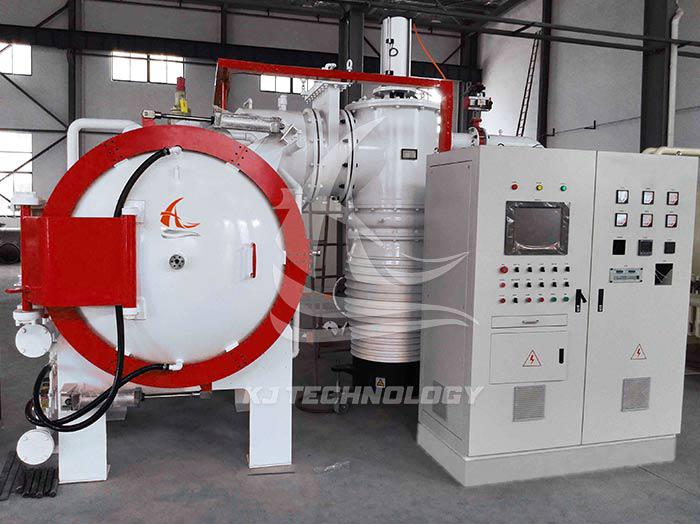Application of Vacuum Heat Treatment Atmosphere Electric Furnace in the Metal Industry
 06-30-2025 Author: KJ technology
06-30-2025 Author: KJ technology
The vacuum heat treatment atmosphere electric furnace is widely and crucially used in the metal industry. By combining vacuum environment with controllable atmosphere, it significantly improves the performance, quality stability, and process efficiency of metal materials. The specific application scenarios and technical advantages are as follows:
1. Core application scenarios
aerospace field
Melting and processing of high-temperature alloys: Melting high-temperature alloys under vacuum or inert gas (such as argon) protection can effectively remove gas impurities (such as hydrogen, oxygen, nitrogen) and harmful elements in the metal, and improve the purity of the alloy. For example, after vacuum heat treatment, the high-temperature strength, creep resistance, and fatigue life of aircraft engine turbine blades are significantly improved, meeting the requirements for use in extreme environments.
Heat treatment of titanium alloys: Titanium alloys are prone to react with oxygen and nitrogen at high temperatures to form brittle phases (such as TiO ₂ TiN), A vacuum environment can avoid such reactions. By vacuum annealing or solution treatment, internal stress of titanium alloys can be eliminated, their plasticity and toughness can be improved, while maintaining surface smoothness.
Steel industry
Quenching and tempering of high-speed steel: Vacuum heat treatment can achieve non oxidative quenching of high-speed steel, avoiding surface decarburization, carbonization, or hydrogen embrittlement problems caused by traditional oil quenching or salt bath quenching. After vacuum quenching, the hardness, wear resistance, and toughness of high-speed steel are significantly improved, and the tool life is extended by 2-3 times.
Surface modification of mold steel: By vacuum carburizing or nitrogen carbon co carburizing processes, a compound layer with high hardness and low friction coefficient (such as Fe-C, Fe-N) can be formed on the surface of mold steel, significantly improving the wear resistance and anti bite performance of the mold, and reducing downtime for maintenance.
Precision parts manufacturing
Gear and bearing heat treatment: Vacuum heat treatment can achieve uniform heating and cooling of gears and bearings, reducing thermal deformation and residual stress. For example, after vacuum pulse carburizing, the surface hardness uniformity of the gears in a dual clutch transmission is ± 1 HRC, and the deformation is only 1/10 of that of traditional processes, which does not require subsequent grinding and directly meets the assembly accuracy requirements.
Micro component processing: The low-pressure heating method in a vacuum environment (mainly relying on thermal radiation) can avoid temperature unevenness caused by convective heating, and is suitable for heat treatment of precision components such as micro gears and springs, ensuring dimensional stability and performance consistency.
2. Analysis of Technical Advantages
No oxidation, no decarburization, no carburizing
The vacuum environment (pressure<10 ⁻ ² Pa) significantly reduces the number of gas molecules and lowers the probability of metal reactions with oxygen and carbon. For example, after vacuum quenching, the hydrogen content of 30CrMnSi steel bolts decreased from 8 × 10 ⁻⁶ to 4.2 × 10 ⁻⁶, significantly reducing the risk of hydrogen embrittlement; The oxygen content of titanium alloy decreased from 0.036% to 0.003%, and the plasticity increased by 30%.
Surface smoothness and quality stability
After vacuum heat treatment, the metal surface is free of oxygen scale and oil residue, presenting a bright "earthy gold" color, reducing subsequent cleaning and shot blasting processes. For example, a certain enterprise has switched its gear shaft heat treatment process from a traditional continuous furnace to a vacuum furnace, eliminating the need for inner hole cleaning and saving approximately 500000 yuan in annual costs.
Deformation control and process flexibility
The temperature uniformity inside the vacuum furnace is excellent (temperature difference ± 5 ℃ at 1200 ℃), and when combined with gas quenching (such as helium and nitrogen), it can achieve controllable cooling rate, reduce thermal stress and tissue stress. For example, high-speed steel dovetail milling cutters do not crack after vacuum quenching, and the deformation is only 1/10 of oil quenching.
Process parameters such as carburizing temperature and gas flow rate can be precisely controlled through simulation software to meet different material and performance requirements. For example, the vacuum pulse carburizing process achieves precise control of the depth of the carburized layer and the metallographic structure through a cycle of strong infiltration (acetylene) and diffusion (nitrogen).
Environmental Protection and Economy
The entire process of vacuum heat treatment is oil-free and oxidation free, without the need for exhaust gas treatment equipment, reducing carbon dioxide emissions and the use of cleaning agents. For example, a certain enterprise's vacuum furnace adopts acetylene carburizing, with no carbon dioxide emissions, and the furnace loading is 50% -60% more than traditional continuous furnaces, resulting in a 40% -60% increase in production efficiency.
3. Typical Process Cases
Vacuum pulse carburizing: Under low-pressure vacuum, high-speed carburizing is achieved by alternately introducing acetylene (carburizing medium) and nitrogen (protective gas). For example, after vacuum pulse carburizing of the input shaft of the 6DCT250 dual clutch transmission, the depth of the carburizing layer is uniform, the metallographic structure has no intergranular oxidation, and the surface fatigue resistance is significantly better than that of the traditional continuous furnace process.
Vacuum high-pressure gas quenching: using argon or helium as the quenching medium, with a pressure of 5-10 bar and a cooling rate of 500 ℃/min, suitable for quenching high-speed steel and mold steel. For example, after high-pressure helium gas quenching, the residual stress of aviation blades is reduced by 40% and the fatigue life is increased by 25%.
4. Industry impact and trends
Vacuum heat treatment atmosphere electric furnace has become the core equipment for high-end manufacturing in the metal industry. Its application not only improves product performance and quality stability, but also promotes process greening and intelligence. With the continuous improvement of material performance requirements in aerospace, new energy vehicles and other fields, vacuum heat treatment technology will develop towards higher vacuum degree, more precise atmosphere control, and more energy saving, further expanding its application boundaries in titanium alloys, high-temperature alloys, composite materials and other fields.








